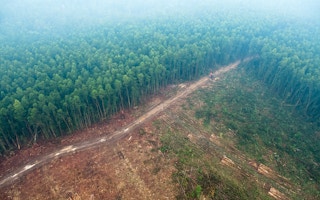Preserving and restoring the world’s forests is arguably the most important thing humanity can do to keep the climate crisis in check as global carbon emissions continue to rise. And yet, despite efforts to protect them, last year was a near record for deforestation in the tropics, home to the world’s most powerful carbon sinks.
To continue reading, subscribe to Eco‑Business.
There's something for everyone. We offer a range of subscription plans.
- Access our stories and receive our Insights Weekly newsletter with the free EB Member plan.
- Unlock unlimited access to our content and archive with EB Circle.
- Publish your content with EB Premium.
So what can we do to safeguard the future of forests while enabling development for the poorest people who live in and around them? Rod Taylor, global forests director for the World Resources Institute (WRI), a Washington-headquartered environmental think tank, believes that, with smarter thinking and the help of technology, there is a future for the lungs of the planet.
Taylor joined WRI in 2016 from World Wide Fund for Nature (WWF) International, where he was forests director, to run WRI’s flagship forest programmes, such as Global Forest Watch, a groundbreaking forest monitoring tool that provides governments and companies with near real-time satellite data on tree cover around the world.
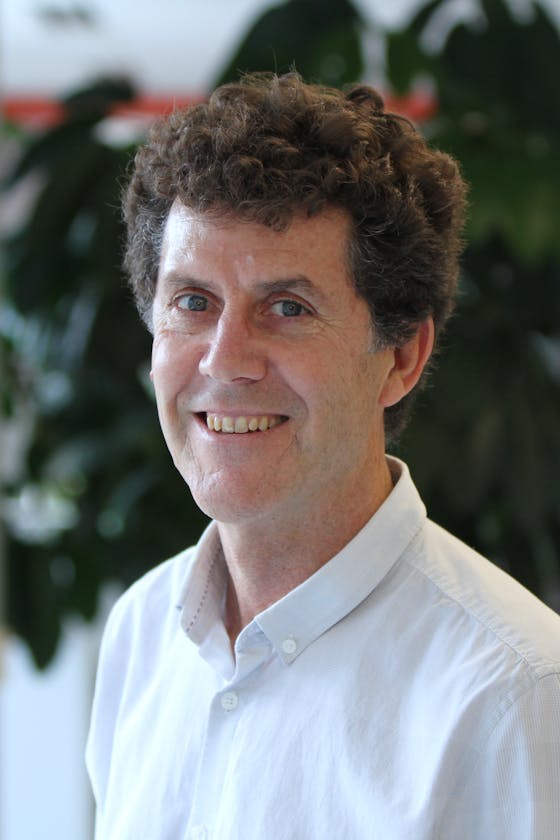
Rod Taylor, global director, forests, World Resources Institute. Image: WRI
Eco-Business caught up with the Australian at the 6th Singapore Dialogue on Sustainable World Resources (SDSWR) on 2 May to ask him which commodities are driving the most deforestation (spoiler: it might not be beef), if certification is working, and how hopeful he is for the future of one of the world’s most valuable resources.
Does protecting forests mean development has to come to a halt in the tropics?
It’s a question of balance. I have a lot of sympathy for the high forest cover argument [countries that are mostly forested should be able to convert some forests for development to alleviate high poverty rates], but more so in countries like Gabon, which is still 95 per cent forested and has solid policies in place to protect forests. But West Papua [which is home to a third of Indonesia’s remaining rainforests] is part of Indonesia and I don’t think the governance is in place to prevent a domino effect—a foothold of development that spreads, and soon you’ve got another Sumatra or Kalimantan, with runaway deforestation.
There’s is an argument for the high carbon stock approach (HCSA) tool, which was invented for countries like Indonesia, home to highly fragmented landscapes with patches of forest. HCSA has done a good job of putting circles around viable forest, and saying these forests are off limits if a company claims that it is deforestation-free. But how does that play out in Gabon or Guyana, where it’s wall-to-wall forest? Are you saying that the whole country is off limits to agriculture? It’s a different conversation.
I used to live in Papua New Guinea. It’s an example of where there needs to be some flexibility. If you can get good rural development outcomes with a cap on deforestation, it can work.
“
There will always be markets that don’t care. There may be squeaky clean supply chains going into Europe and the US, but what about the big domestic markets of Brazil, India or China?
How hopeful are you for tropical forests right now?
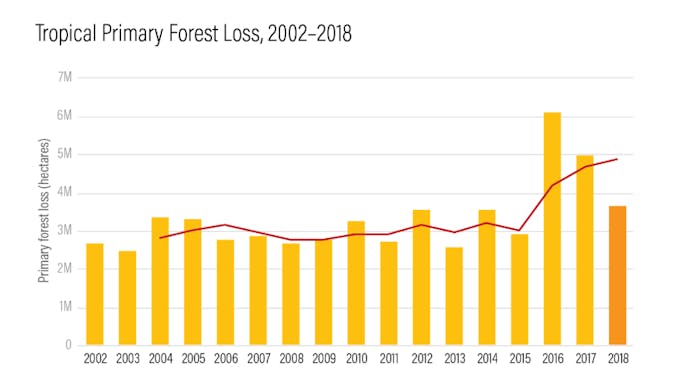
Tropical primary forest loss 2002-2018 (click to enlarge). Source: World Resources Institute
The rate of tropical forest loss was flat for a long time until 2015, when there was a dramatic spike in a year of intense fires [the haze of 2015, caused by slash-and-burn forestry in Indonesia, was the worst in Southeast Asia’s recent history]. It has fallen since, but to a higher level than before 2015. An area the size of Belgium was lost last year. While that is not as dramatic as 2015, it is significant and does not include what has been hacked out of dry woodlands in East Africa, as that doesn’t show up as dense forest cover by the satellites.
Has progress been made at protecting forests?
After years of certification and traceability efforts by the forestry industry, it is harder for a company to go into a frontier region [such as Papua or Gabon] and start hacking away out of sight. NGOs are investigating which companies are linked to which, making it harder for companies with opaque corporate structures to hide from deforestation. Meanwhile, the drive for more consistent data sets has meant that we’re slowly getting clarity on concession boundaries in Indonesia.
But business can only go so far. There will always be markets that don’t care. There may be squeaky clean supply chains going into Europe and the US, but what about the big domestic markets of Brazil, India or China? That’s the big question—will those big markets get more discerning?
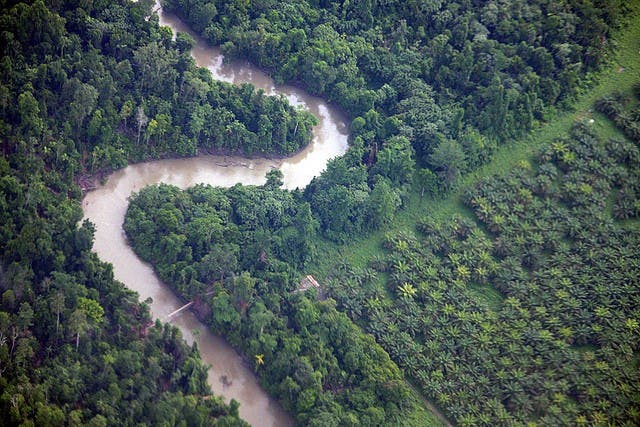
The edge of a palm oil plantation in West Papua, Indonesia. Image: Michael Thirnbeck, CC BY-NC-SA 2.0
Which commodity is driving the most deforestation? Palm oil has taken the most flak by the international media and NGOs. But the palm oil industry argues that it is a high yielding crop and other commodities such as soy and beef are more to blame.
The jury’s out on palm oil. If palm oil companies want to access premium markets, there’s a business risk in deforestation. But there’s a question mark over the right model for smallholder palm farmers in Indonesia [who are often blamed for driving most of the deforestation]?
The European Union’s renewable energy directive [which has banned palm oil imports for biofuel because of the crop’s links to deforestation] is seen as a swipe against palm oil in this region [Malaysia’s Primary Industries Minister Teresa Kok called the EU’s stance on palm oil is “unfair” and “discriminative” at SDSWR].
But the fundamental reason it’s been clamped down on is the contention as to whether bio energy produces greenhouse gas emissions savings. If palm oil grown for bio energy is shifting agriculture to other areas and causing further deforestation, it is not. The analysis of recent history shows that a lot of forest conversion is linked to palm oil, and an increasing share of that is going into bio energy.
There is the same point of contention with wood. There are some big assumptions on whether wood is carbon neutral, and a powerful lobby from the timber industry in Europe maintain that it is. But the moment you cut anything down it takes a while to grow back. So there’s a question about whether carbon debt is created in the short term, which is not helpful for the climate change agenda.
What about soy, which requires far more land to grow than palm oil and is also a major drive of deforestation?
Soy is very much linked to the politics in Brazil [which saw decade-high deforestation rates in 2018]. With the election of Jair Bolsonaro [as president in January 2019] there’s a big question as to whether the states will hold the line [to protect forests; Bolsonaro has pledged to roll back protection of the Amazon, the world’s largest rainforest].
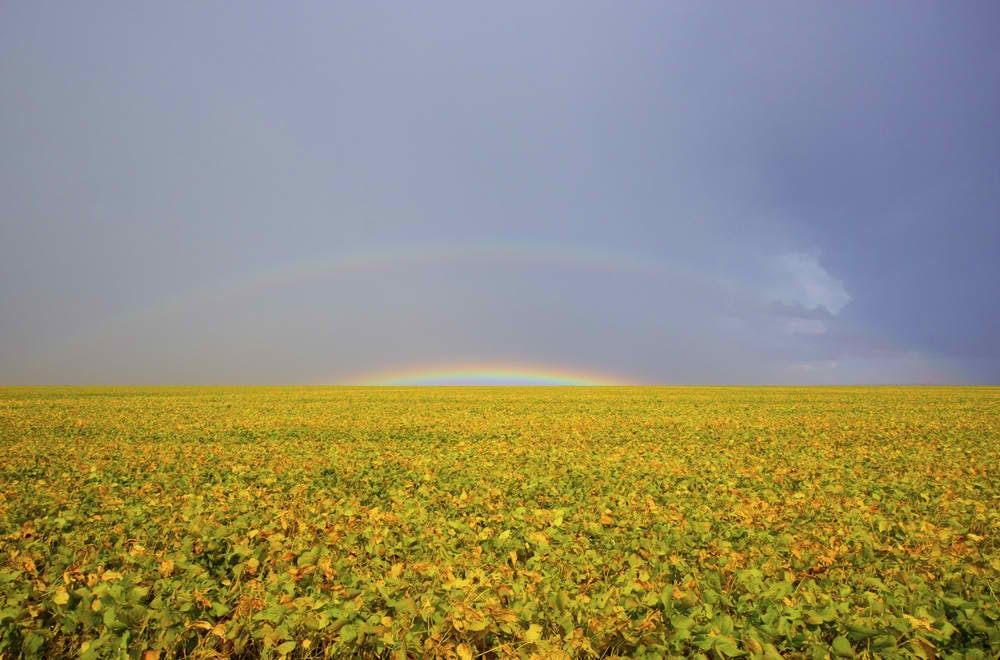
A soybean plantation in Sao Jose do Rio Claro, Mato Grosso, Brazil. Growing demand for meat from China’s new middle classes is driving the growth in South American soya imports, which are used principally to feed livestock. Image: Shutterstock
And what about beef, which is said to be the first thing people should stop eating if they want to lead a more sustainable lifestyle?
Beef is accused of being the biggest driver of deforestation—which it is. But often deforestation is caused by people claiming land. When America and Australia opened up, people put cows on the land as a way to stake a claim to it, and the same is happening in poorer parts of Brazil. I’ve been to places where there’s just one of two cows per hectare, and it’s really just people claiming territory. If those people then re-sell the land to soy or cattle farmers, then the deforestation is indeed being driven by beef.
And rubber and cocoa?
It boils down to commodity prices. Rubber was a big problem a few years ago, when rubber prices were high. But as prices have fallen, rubber is not as implicated in deforestation. The Global Platform for Sustainable Natural Rubber [which launched in March] has the opportunity to set the right framework so that if rubber prices rise again, we don’t see a surge in land grabbing and forest clearance.
Likewise, cocoa has an opportunity to make debilitated planting regions more productive and encourage tree cover within them rather than opening up new areas. Palm oil is similar. If smallholders can be more productive, as long as that doesn’t create a massive incentive to open up even more forest, they can be part of the solution.
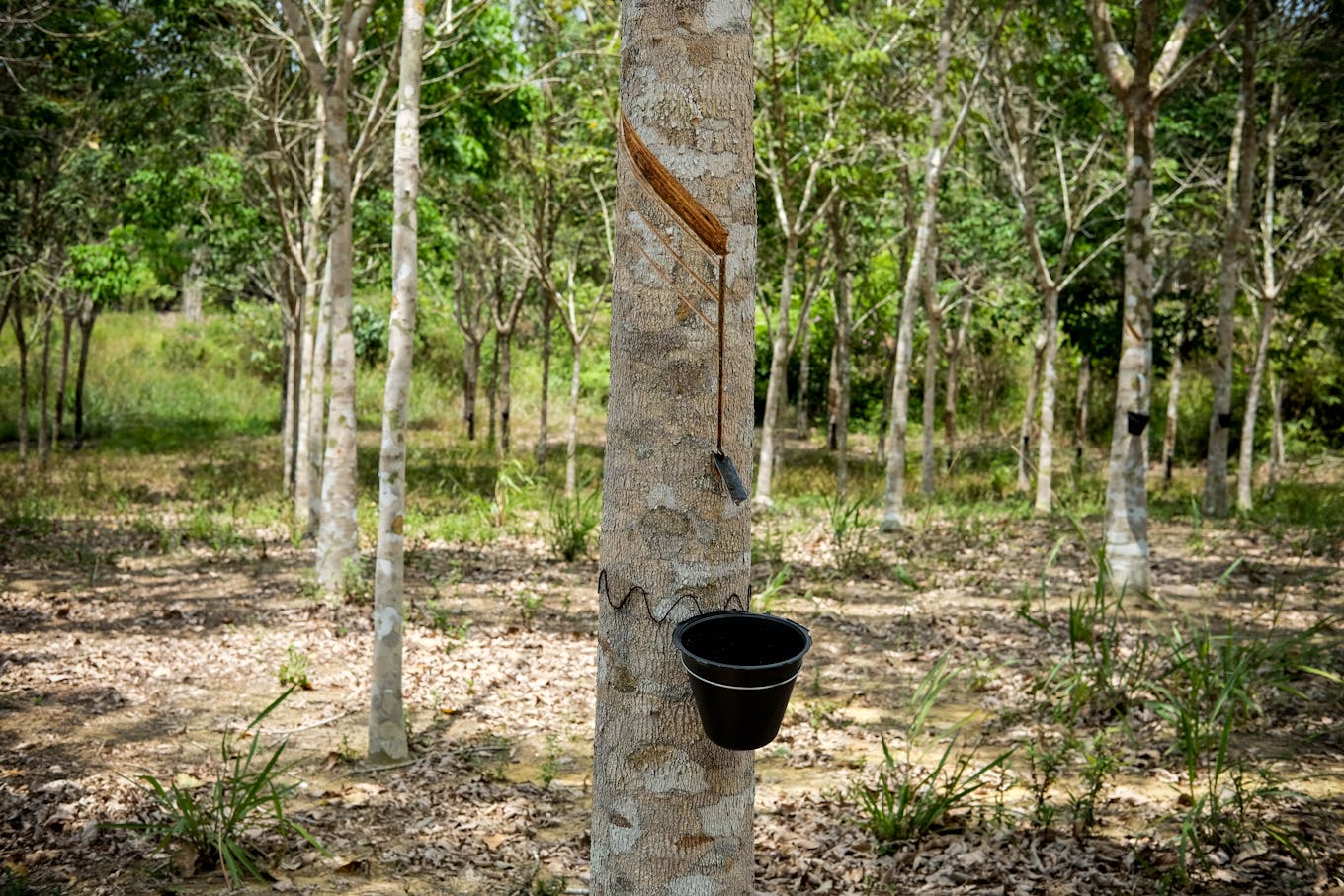
A rubber plantation in Bintan, Indonesia. Image: Eco-Business
Are there any sectors that get overlooked for their role in deforestation?
Mining. The holes in forests created by mining tend to be quite small, but the roads and ports that go with them open up large areas for development. But because there’s a lot of money in mining, there’s a big opportunity for mining companies to protect the forested areas around the mine.
There is little chance that consumer goods companies such as Mars, Unilever and Procter & Gamble will hit their target of zero deforestation in their supply chains by 2020. So what do they do next?
I think we have to shift to performance-based monitoring of these pledges. This is where tools like Starling [a satellite monitoring tool just launched by Nestlé to monitor deforestation in its supply chain] and Global Forest Watch Pro will give companies the ability to quantify risk. We need to put numbers on progress. At the moment, companies are making promises and saying we’re doing all this good work, but without reporting actual numbers—so we can’t hold their feet to the fire.
So what can these companies do better?
They should start reporting honestly on their impact of their supply chains on forests, and recognise that it’s better to not completely withdraw from the deforestation trouble spots. You can easily achieve a 100 per cent deforestation-free supply chain by, say, boycotting Indonesia. But it’s not going to solve the problem. If you’re going to solve complex problems of governance in deforestation-prone areas, it’s better for companies to be involved and help to drive deforestation out of those places. The trick is, can companies stay true to their commitments while staying engaged in driving reform?
What’s your view on the effectiveness of certification bodies such as Roundtable on Sustainable Palm Oil (RSPO) and Forest Stewardship Council (FSC) in protecting forests?
If we don’t have certification, we’d have to invent something similar. Because to tackle deforestation, you need stakeholder agreement mechanisms, standards, and verification—you can’t just have companies saying ‘trust us, things are going swimmingly in our supply chains.’ If you want to go beyond certification, build on it rather than rebuild it from scratch; to create a new certification system would be a hugely costly and labour intensive exercise.
What’s wrong with certification?
Certification bodies like RSPO and FSC are multi-stakeholders forums, where a lot of dialogue happens. That’s a good thing. But it is difficult to blend that with a certification system, which has to be certain, predictable and clear. It’s tricky to be constantly reinventing yourself through stakeholder dialogue if at the same time you’re trying to give a clear signal of what’s acceptable and what’s not to the market.
How can certification improve?
Technology can help move certification into the 20th century. You do not need to trace every commodity from the source to the end product if we take a more risk-based approach to supply chains. For instance, when assessing palm oil supply chains, do you really need to closely look at palm oil coming out of peninsula Malaysia, where there is zero risk of deforestation because forests were cleared in colonial times? A smarter investment in traceability would be to look more closely at troubled areas, where there are good and bad actors operating in the same district.
What’s your view on the progress made by paper giants Asia Pulp & Paper (APP) and Asia Pacific Resources International (APRIL) in stopping deforestation?
The pulp and paper sector in Indonesia was late to the party [in stopping deforestation]. They eventually came through with no-deforestation commitments [APP’s in 2013, APRIL’s in 2015], but they have huge legacy issues to deal with. For me, with such historical deforestation from these companies, you don’t get out of jail overnight. They’ve both got pretty major commitments to rehabilitate forest areas to atone for their sins. I realise that there are challenges in those commitments, and it’ll take time. But they have to show good faith in dealing with their legacy issues.
APRIL is in a better place than APP on that front. It has more forest within its concessions that it can work with on those commitments. But APP’s concessions were pretty much all fully developed in the race to get wood supply, so it has to work harder on its operations to achieve its commitments.
There’s been some hiccups regarding third party suppliers and whether they’re part of the APP corporate group [an investigative report by Associated Press in 2017 found that APP’s parent company Sinar Mas has undisclosed ties to companies linked to slash-and-burn forestry and deforestation].
But broadly, the two companies have held a high line in keeping bulldozers out of new areas. It’s really a question of whether they can live up to their conservation and restoration pledges, and prevent any backsliding.
The big question mark with APP is, when the OKI mill [the PT Ogan Komering Ilir (OKI) mill in South Sumatra has worried environmentalists who say the massive facility will inevitably lead to forest fires and haze in the region for decades to come] goes full steam ahead, where’s that wood supply going to come from?
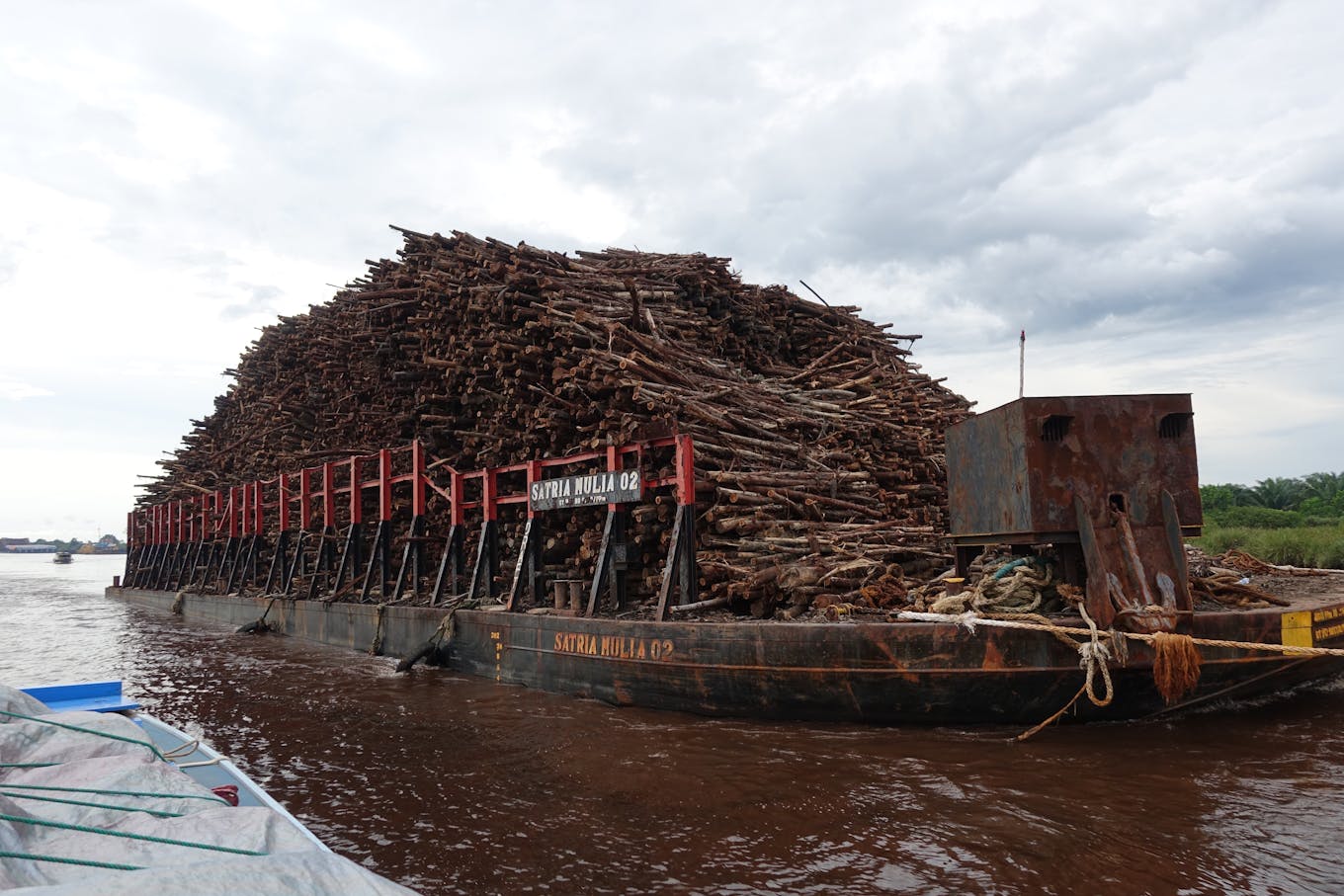
A log barge cruises up a river towards APP’s OKI pulp mill in South Sumatra, Indonesia. Image: Eco-Business
What worries you the most about the future of forests?
How to do forestry and agriculture in ways that are resilient to climate change is a big hairy question. We’ve been focused on reducing emissions from those sectors. Now, as we see more severe weather events and more heat, are those ecosystems in good enough condition to be able to withstand what climate change is going to throw at us? Are we going to see negative feedback loops? For example, in Brazil there is a lot of degraded forest that’s close to farms. This forest would never have burned under full canopy cover, but now that’s drying out we’re seeing lots of fires.
If we fail, these systems can collapse pretty quickly. But the dialogue is switching from just stopping deforestation to looking at better ways to remove carbon from the air through natural ecosystems, instead of investing a lot of carbon capture technology. What can we do in the landscapes to get them sucking more carbon out of the air? This is the big restoration opportunity we’ve got to rise to.

